Reviving Thai Design in Neo-traditional Houses
Reviving Thai Design in Neo-traditional Houses
วันที่นำเข้าข้อมูล 15 Nov 2021
วันที่ปรับปรุงข้อมูล 30 Nov 2022
Reviving Thai Design in Neo-traditional Houses
Traditional Thai houses are a prominent part of the iconography of old Siam. However, they are not merely things of the past.
In ancient times, Thai architecture provided some of the best lifestyles of the era and practical protections from the natural world. Today, however, modern houses of reinforced concrete have become the norm, as new technologies rendered traditional styles obsolete and foreign designs offered enticing alternatives.
Despite the abundance of material reasons to transition away from them, the design elements of the Thai traditional house have nevertheless continued to manifest in “revivalist” recreations today.
This article will describe the features of traditional Thai houses before examining how competing currents led Thais to embrace practical modern designs from abroad while maintaining their own unique heritage in living spaces.
Features of traditional Thai houses
As Ancient Siam was a patchwork of different kingdoms with various architectural styles, the term “traditional Thai house” is extremely broad. For simplicity, we will focus on the classical style developed in the Ayutthaya Kingdom, which reigned over most of central Thailand from the 14th – 18th centuries. This central style has come to be the single most prominent in historical imaginings today.
Practical design elements
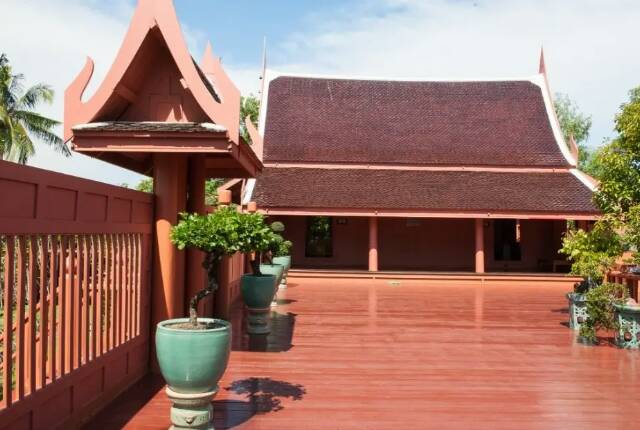
Unlike their modern counterparts, traditional Thai houses were constructed mainly of teak or other hardwood materials. They stood on now-iconic stilts to avoid the annual floods of the Chao Phraya River basin.
Structurally, these houses were less compact than today’s residences, preferring individual rooms to be accessed via a large open-air platform called chān. These often represent a significant portion of the house, sometimes taking up to 60% of floor space. This allows for maximum airflow and natural light in each room, and is reflective of Thailand’s warm tropical climates, which make outdoor recreational spaces more favorable.
Maximizing light and air flow was also the rationale for their pitched roofs and large windows. The steep pitched roofs also alleviated the impact of rainfall during the monsoon season. As a result, Thai traditional houses were adapted to both mitigate and benefit from tropical climates, while maintaining their elegance and cosiness.
Cultural significance
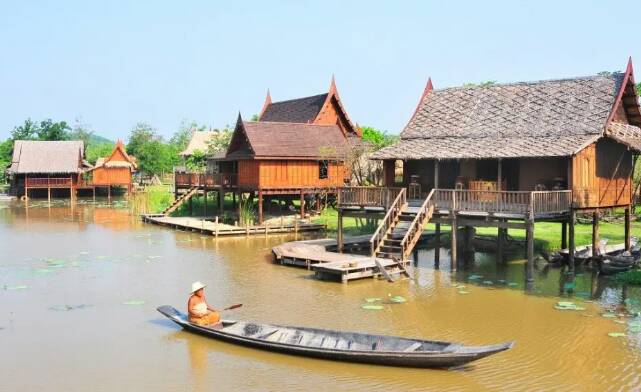
Aside from this versatile construction style, traditional houses are also embedded with Siamese cultural values. For example, a general philosophy held by the Thai people emphasized living close to nature. These structures allowed residents to live close to water, an important source of food and transport. By using wood and stilts, the house could be amidst nature without impacting or destroying it. In larger or wealthier households, the space afforded by the chān was also used to grow fruit trees, which demonstrates the harmony between the house and its natural surroundings.
Read More: Navigating Thailand’s Water-based Culture
The designs within the house also served the Thai lifestyle. As Thais were primarily floor-dwelling, traditional houses were free from any built-in furnishings. Furniture was always squat and low in the absence of chairs. The use of stilts also supported this lifestyle by raising the floor away from the ground. Outside of monsoon, the area under the house (tai thun) could be used to store household items and shelter livestock.
The aforementioned chān has also been used to aid the cultural norm of living within large extended families. Traditionally, upon marriage, grooms would go live with their bride’s family in adjacent or nearby dwellings. The additional houses constructed for children to live with their spouses could be adjoined to the original house by extending the chān and using it as a connective passage.
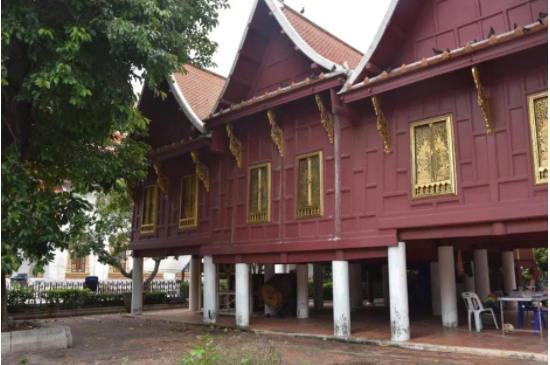
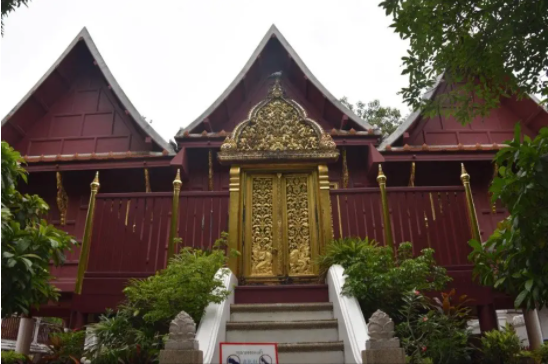
A surviving example of such a house is found in Wat Rakhang, Thonburi district—a library which was formerly the residence of King Rama I (1782 – 1809). The structure has been modified to fulfill its new function, but it still features all of the classic design elements. The entire structure sits on stilts, and the steep pitched roofs, large windows, and a chān are all visible.
Evolution towards “modern” houses
Despite being highly adapted to the local climate and culture, the Thai house evolved over time, eroded by its physical limitations and the import of new styles and technologies from abroad.
The problems inherent in a wooden house are obvious. Wood deteriorates from exposure to moisture and pests such as termites and is flammable. Indeed, the Siamese realized this early on—by the 17th century, brick houses had become prominent amongst those who could afford them. Additionally, irrigation along the Chao Phraya during the 20th century also made flooding less prevalent, reducing the need for stilts.
Changing tastes also played a significant role in phasing out the traditional Thai house. A gradual, but effective Westernisation, spurred by colonial pressures starting in the mid-19th century, shifted public tastes to more “modern” styles of housing. While these houses were still made of wood, they were condensed into a compact single-unit structure, rather than consisting of small rooms adjoined by a patio. The import of conveniences such as air conditioning and electric lighting also made many of its open-plan design features obsolete.
The houses that emerged from these changes resembled European houses in their detail, adopting lower gables and brightly painted in pastel-like colours. They were still mostly constructed out of wood and, in many cases, brick and mortar; the change into concrete would only occur later in the 20th century. Such structures can be viewed throughout old Bangkok, such as the Vimanmek Palace, inaugurated in 1901.

Ironically, the preference for “advanced” modern architecture also made building traditional Thai houses more difficult. The skills needed to construct the complex interlocking teak structure became more rare and, thus, more expensive, while rapid urbanization and deforestation also raised the price of wood. All of these contributed to the growing prevalence of the “modern” house.
Preservation and resurgence
By the mid-20th century, Thais experienced the comforts of air conditioning and artificial lighting. Why, then, did some return to the old style?
Tourism
Tourism can be partially accredited with reviving many classic design elements. In an age dominated by concrete apartment blocks, visitors to the Kingdom desired a nostalgic and somewhat rosy experience of Thai heritage. Hotels, resorts, and restaurants would cater to this, albeit with a modern twist.
Experiencing the true lifestyle in a traditional house, sans air conditioning and with complimentary mosquitos, may be altogether unpleasant. Therefore, a compromise was inevitable.
Most commonly, the area under the stilts would be walled and glazed, forming additional living spaces. At times, the upper floors would be a mixture of concrete and wood. External spaces like the chān are reduced to a mere balcony or completely covered by a roof, with the upper floors accessible by interior staircases as opposed to exterior ones. In essence, it is an air-conditioned box with Thai pitched roofs.
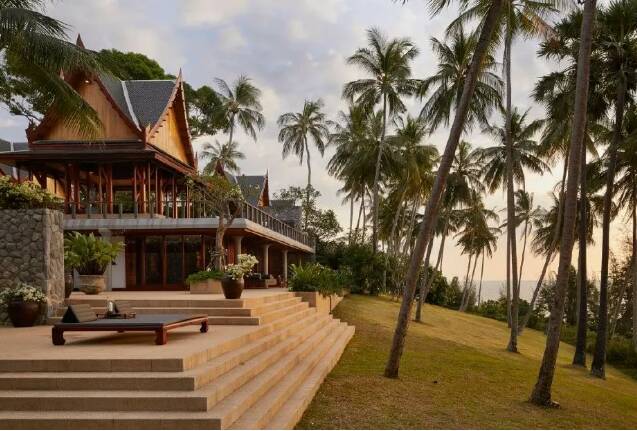
Personal tastes
Amongst locals, individualism and personal taste play a big role. Older homeowners, especially those who live in rural areas, are comfortable in traditional settings that bring back fond memories of their youth. This desire has led to the revival of classic design elements in private homes, though many of them have also been adapted for modern living in a similar manner to hotels. Some even continue to inhabit true traditional houses, which can be seen in areas such as Phra Pradaeng in Samut Prakan province.
Ancestor worship
Additionally, architects looking to integrate these classic design elements into modern houses have benefited from the preservation of ancient houses. They can thank the concept of spirit worship, a Thai Buddhist belief originally stemming from animist folk religions.
Thais preserve old houses to respect the spirits said to be dwelling within them, and many still refurbish and adapt their ancestral homes to show respect for their predecessors. The continued existence of these homes makes it easier for Thais to remain in touch with classical design elements that would otherwise erode over time.
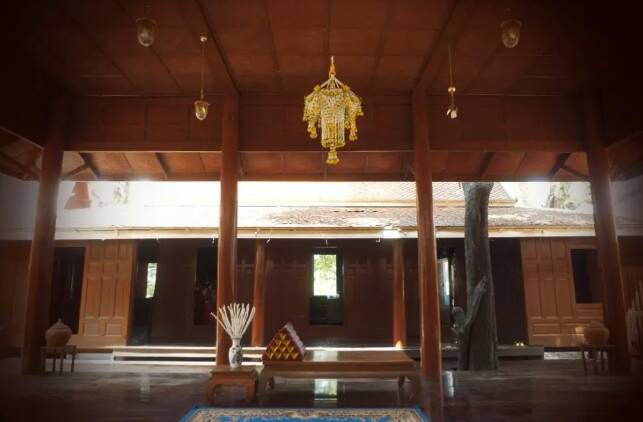
In following global trends, houses in Thailand have been modernized in line with both material needs and broader changes in taste and fashion. However, due to deeply cultural reasons, the aesthetic of the traditional Thai house continues to occupy the minds of contemporary architects and designers.
Both modern revivalist houses and the preservation of genuine structures contribute to the lasting appreciation of Thai culture.
สถานเอกอัครราชทูต ณ กรุงเตหะราน
Office Hours: Sunday to Thursday, 08:30-12:00 and 13:00-16:30 (Except public holidays)